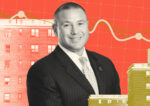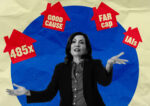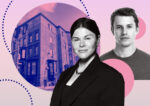 Real estate lender dodges bullet after Signature’s collapse
Real estate lender dodges bullet after Signature’s collapse
Trending
Office defaults send bad debt at NYCB up 2,500%
Two loans marked nonrecoverable account for most of increase

New York Community Bank reported a surge in bad debts. The cause: office properties.
Across the bank’s loan portfolio, charge-offs or debt deemed nonrecoverable rose to $26 million in the third quarter, up from just $1 million in the same period last year.
Commercial real estate loans, most of them backed by office properties, accounted for $14 million in charge-offs in the quarter, compared with zero a year ago.
CEO Thomas Cangemi blamed two office loans: a $28 million mortgage on a Syracuse property and a $112 million loan tied to a Manhattan building.
Cangemi did not name the troubled properties, but court records suggest the Syracuse building is owned by AMTrust Realty.
In late September, New York Community Bank subsidiary Flagstar Bank filed to foreclose on AMTrust’s Equitable Towers, two buildings at 100-120 Madison Avenue in Syracuse, a complaint shows.
AmTrust had defaulted on the property’s $28 million loan in May. AmTrust did not immediately return a request for comment.
John Adams, New York Community Bank’s president of commercial real estate finance, said when the loan was made in 2012, the loan-to-value ratio was no higher than 65 percent — a healthy margin of safety for the lender.
When the property was reappraised, the ratio had jumped above 100 percent. When a property’s debt exceeds its value, the owner is prone to walking away.
Adams noted “the impact of the pandemic and obviously leasing activity and vacancies” when explaining the increase.
As for the Manhattan default, Cangemi emphasized that it was small potatoes compared with the bank’s overall office loan book.
“It’s one loan,” Cangemi said. “So we have a very strong portfolio.”
It’s unclear what property accounted for the $112 million default.
NYCB made a $117 million loan to AmTrust Realty to finance 250 Broadway in June 2012, property records show.
In April 2, The Real Deal reported AmTrust President Jonathan Bennett was overhauling 250 Broadway to attract a major tech tenant. The firm was trying to fill seven floors vacated by a city agency in the 30-story tower, built in 1962.
“I don’t see Class B as a business I want to be in,” Bennett said at the time. “I want to be in the Class A business.”
A spokesperson for AmTrust said the $117 million loan had been paid off.
The majority of NYCB’s office loans are collateralized by properties in New York City where remote work is forecast to deplete values by 44 percent, according to a study by New York University and Columbia University researchers.
In the third quarter of 2023, Class B and C properties had already depreciated 20 percent since the start of the pandemic, an Avison Young report found.
On the multifamily front, NYCB reported $2 million in net charge-offs, twice the figure from the same quarter last year. Multifamily loans marked 30 to 89 days past due rose 76 percent year-over-year to $60 million, the largest increase across the firm’s loan book.
The majority of the bank’s multifamily debt is tied to rent-regulated buildings, an asset that has seen valuations decline from 20 to 45 percent since a 2019 law strangled rents.
Analysts on the Thursday morning earnings call pressed Cangemi on the health of the bank’s rent-stabilized loan book.
“Starting to see any kind of cracks there?” asked Stephens’ Matthew Breese. “It just feels like there’s a pile-up of issues from the 2019 rent law.”
Cangemi attributed any distress to “one-off families.” NYCB filed to foreclose on eight rent-stabilized properties owned by two families in July.
“It’s not systemic,” Cangemi said.
Adams tied the troubles affecting rent-stabilized properties to tenants who have failed to pay rent.
The bank’s executives pointed to New York’s high market rents as a strong point for multifamily, rent-stabilized included. Many rent-stabilized buildings have a mix of regulated and market-price units. Revenue from the latter can offset the former’s stagnant growth.
But landlords say rent-stabilized buildings have been able to withstand the rent law only if they are majority market-rate.
Brokers and landlords say that rent-stabilized distress is mounting, a claim backed up by some court filings.
Cangemi said the bank is not seeing that larger trend.
“You just can’t kill the New York multifamily market,” Adams said.
This article has been updated with a comment from an AmTrust Realty spokesperson.
Read more
 Real estate lender dodges bullet after Signature’s collapse
Real estate lender dodges bullet after Signature’s collapse
 NYCB touts no multifamily delinquencies. Earnings say otherwise
NYCB touts no multifamily delinquencies. Earnings say otherwise
 Rent-stabilized owners suffer swell of foreclosures
Rent-stabilized owners suffer swell of foreclosures




